Elephant Ear Plants: Types, Flowers, Leaves, and Care (With Pictures)
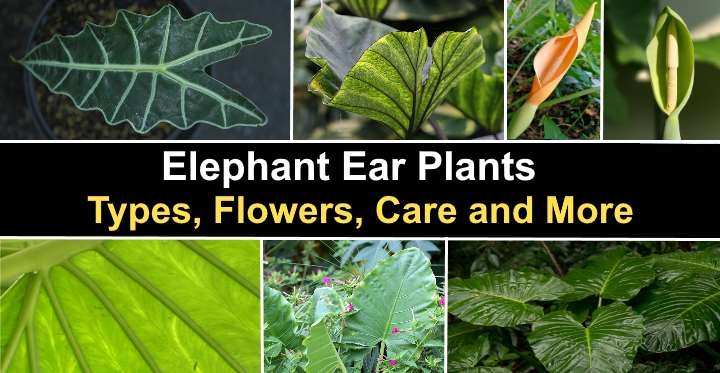
Elephant ear plants are famous for their enormous heart-shaped and arrowhead leaves. Elephant ears are species of perennial tropical plants that thrive in warm, humid conditions, growing in moist soil. The large striking triangular leaves add a tropical touch to your summer garden or home’s interior. Elephant ear plant leaves grow at the end of thick stems from bulbs or tubers in the ground or pots.
“Elephant ears” is the common name for leafy aroid plants in the genera Alocasia, Colocasia, Caladium, and Xanthosoma in the family Araceae. Apart from growing huge tropical leaves, elephant ears also produce flowers that look like calla lily flowers. However, it’s rare for elephant ear houseplants to bloom indoors.
Elephant ear plants are native to tropical countries. Most varieties of elephant ears thrive outdoors in zones 9 through 11. A few Colocasia and Alocasia species are cold hardy to zone 7. However, in general, elephant ears don’t grow in the cold and can’t tolerate frost.
If you live in temperate climates, you can grow elephant ears in your garden as annuals. Or you can dig up elephant ear bulbs and store them in a dry, cool place indoors, ready for planting in spring. Of course, these leafy tropical plants grow well in containers and are excellent as patio, deck, porch, or backyard potted plants.
This article is a guide to the various types of elephant ear plants you can grow in your garden or indoors. You will also get helpful tips on growing these robust lush tropical plants.
Elephant Ear Plant Care
To care for elephant ear plants, grow the ‘bulbs’ in well-draining soil that is kept moist. Elephant ears—growing indoors or outdoors—need plenty of sunlight, humidity, and water to thrive. Fertilize every two weeks during the growing season. Indoors, grow potted elephant ear plants in indirect sunlight. Outdoors, plant elephant ears in full to partial sun.
Common Types of Elephant Ears (Alocasia, Colocasia, Caladium, and Xanthosoma)
Elephant ear plant types belong to four tropical plant genera in the family Araceae. These aroid plants share some characteristics with their striking heart-shaped or arrowhead leaves that grow from corms or tubers.
Here is a brief overview of the four main species of elephant ear plants.
Alocasia
Alocasia plants are popular houseplants due to their dark green waxy leaves with striking creamy-white prominent veins. Also called the African mask plant or Kris plant, Alocasia plants grow between 2 and 6 ft. (0.6 – 1.8 m). Alocasia leaves measure between 8” and 35” (20 – 90 cm) long.
Related reading: How to care for Alocasia plants.
Colocasia
Colocasia plants are also called Taro plants, and they have downward-pointing fleshy leaves that can be lush green, red, or purplish-black. The large elephant ear leaves are enormous and grow between 8” and 5 ft. (20 cm – 1.5 m) long. After cooking, taro tubers of some species are edible and are a common food in Asia.
Caladium
Caladium plants have colorful heart-shaped leaves with spectacular color combinations such as red, green, cream, white, pink, and silvery-green. Like Alocasia plants, Caladium elephant ear leaves typically have prominent, brightly-colored veins. Caladium plants grow between 6” and 3 ft. (15 – 90 cm). Shade-loving Caladium plants are also called ‘Heart of Jesus’ and ‘Angel Wings.’
Xanthosoma
Xanthosoma plants are flowering elephant ear plants with characteristic pointed arrowhead-shaped (sagittate) leaves. Xanthosoma isn’t usually grown in gardens or containers.
According to the University of Wisconsin-Madison, the leaves of Elephant ear plants (Colocasia, Alocasia, and Xanthosoma) are edible but they must be cooked first. The leaves contain calcium oxalate crystals that cause severe skin irritation and they must be cooked first.
According to the ASPCA, Elephant ears that belong to the Caladium genus are poisonous to dogs, cats, and horses and can cause oral irritation due to their insoluble calcium oxalates.
Elephant Ear Flowers
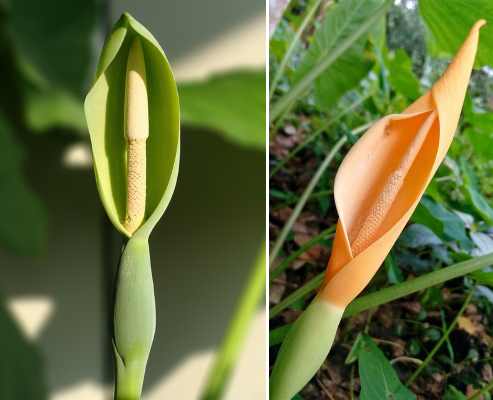
Elephant ear flower – close up pictures of elephant ear Alocasia macrorrhizos flower (left) and elephant ear Colocasia esculenta flower (right)
Elephant ear plants are species of flowering plants that produce aroid-type flowers. Elephant ear flowers usually have a white or green spadix surrounded by a spathe leaf. Elephant ears rarely bloom indoors, and flowers are uncommon when growing outdoors. The small flowers generally are unnoticeable under the vast leafy foliage.
Elephant Ear Bulbs
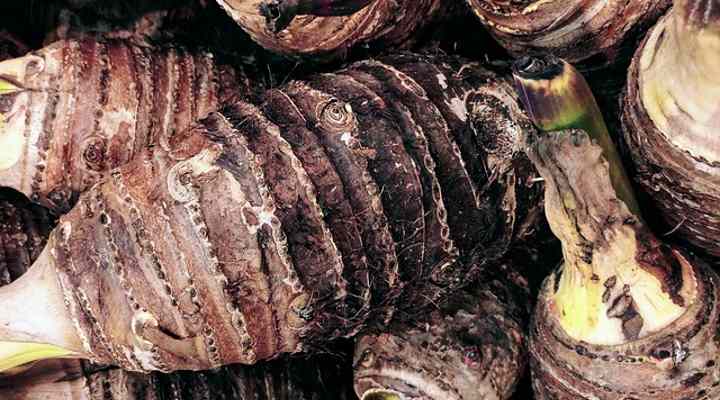
Elephant ear bulbs: closeup picture of caladium tubers
Elephant ear plants grow from tubers or corms that people generally refer to as bulbs. In tropical climates, the elephant ear plant bulbs grow throughout the year in zones 9 through 11. In temperate climates, the bulbs won’t survive winter outdoors. So, it’s essential to overwinter elephant ear bulbs indoors or grow them as potted houseplants.
Related reading: How to care for elephant ear plants.
Elephant Ear Leaves
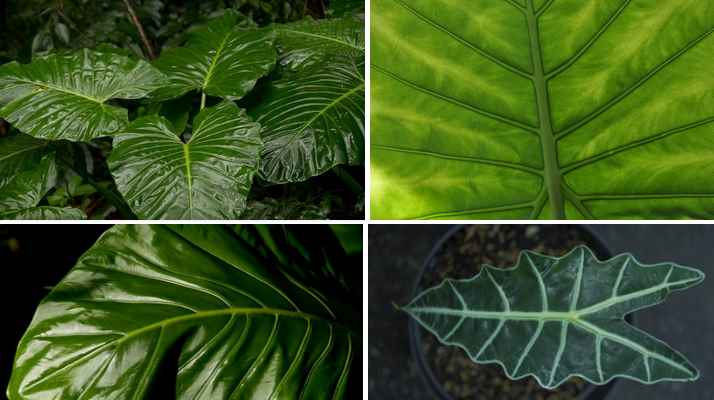
Elephant ear leaves: closeup pictures of Alocasia elephant ear leaves that are heart or arrow shaped with prominent veins
Elephant ear plant leaves are the most attractive feature of these stunning tropical foliage plants with big leaves. Elephant ear leaves are sagittate-shaped that look like pointed hearts or arrowheads. The smooth, waxy leaves generally have prominent veins in colors contrasting with the lush leaves.
Depending on the species, elephant ear leaves point either upward or downward. Typically, Alocasia and Xanthosoma leaves point upward or outward. Species of Colocasia and Caladium have showy leaves that point to the ground.
The leaves of elephant ears can have various colors such as green, black, pink, red, cream, and purple.
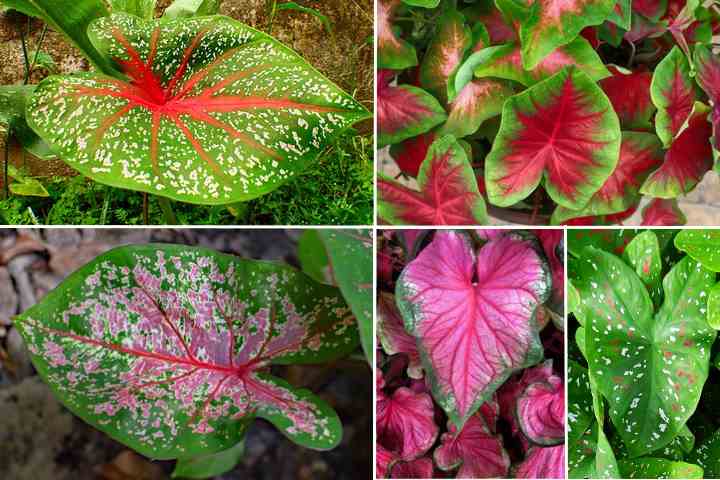
Elephant ear leaves: closeup pictures of Caladium elephant ear leaves that come in a wide array of colors such as red, pink, green and cream
It doesn’t matter which type of elephant ear plant you grow. The magnificent arrow- or heart-shaped leaves will make your backyard or interiors look like a tropical landscape.
Types of Elephant Ear Plants (With Pictures)
Let’s look in more detail at some stunning examples of large-leafed tropical plants in the genera Alocasia, Colocasia, Caladium, and Xanthosoma.
Amazonian Elephant Ear (Alocasia x amazonica)
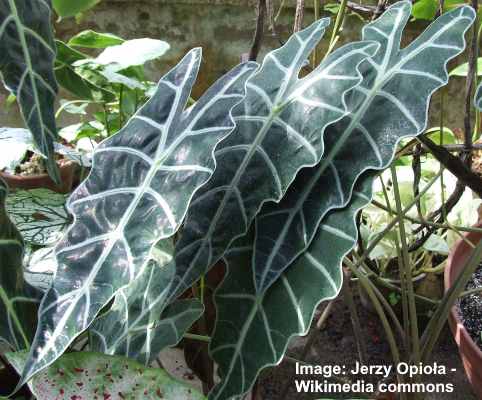
Alocasia amazonica (Amazonian Elephant Ear) is a popular houseplant with dark green arrowhead shaped leaves with pale veins
The Amazonian elephant ear plant is one of the most popular ornamental houseplants. The striking glossy arrowhead leaves are dark green with prominent creamy-white ribs. The relatively narrow pointed lush green leaves have wavy edges to add to the plant’s tropical appeal. The sagittate leaves grow up to 2 ft. (0.6 m) long.
This elephant ear plant is also called the African mask plant or Kris plant.
Grow African mask plants in indirect bright light indoors. Keep the soil moist without being too soggy. When the temperature is at least 65°F (18°C) outside, you can grow Amazonian elephant ears in the ground in your garden.
Compact Amazonian Elephant Ear (Alocasia x amazonica ‘Polly’)

‘Polly’ cultivar (Compact Amazonian Elephant Ear) is a small version of the large Alocasia amazonica plant
The Amazonian ‘Polly’ cultivar (compact Amazonian elephant ear) looks like a smaller, compact version of the large Alocasia amazonica species plant. The popular ‘Polly’ elephant ear plant has waxy green leaves with whitish veins like the larger Amazonian elephant ears. This small tropical houseplant only grows up to 2 ft. (60 cm) tall.
To care for this compact elephant ears plant, give it plenty of warmth, humidity, and moisture. Like the larger Amazonian elephant ears, the ‘Polly’ cultivar grows in indirect light and grows well in partial shade.
Mammoth Elephant Ear (Alocasia macrorrhiza)
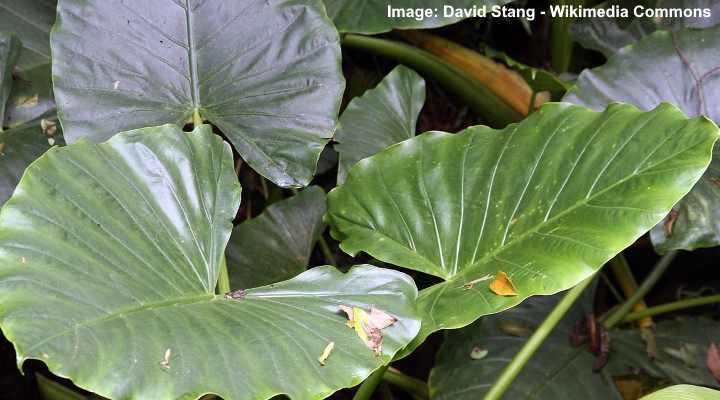
The gigantic elephant ear Alocasia macrorrhiza plant has very large thick green leaves
The Mammoth Elephant Ear has gigantic leaves that grow up to 6 ft. (1.8 m) long and 4 ft. (1.2 m) wide. The thick ruffled green leaves grow on thick stalks that emerge from the large bulb. Like most Alocasia plants, the mammoth elephant ears point upward and give your garden a tropical look.
Also called the Giant Taro or Upright Elephant Ear, the magnificent plant grows in USDA zones 9 through 12. You can also grow the evergreen perennial plant as an annual in colder climates if you winterize the bulbs from fall until spring.
Calidora Upright Elephant Ear (Alocaisa ‘Calidora’)
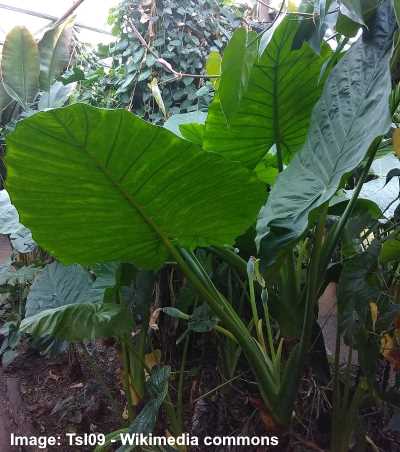
Elephant ear Alocasia ‘Calidora’ has large upright ribbed leaves
The upright elephant ear (Alocasia ‘Calidora’) has colossal leaves that can be taller than a person. The upright Alocasia leaves are rounded arrow-shaped that grow up to 6 ft. (1.8 m) tall. The green leaves have a ribbed texture. Grow Calidora elephant ears in zones 10 through 12. This tropical plant grows in full sun to almost complete shade.
Alocasia Zebrina
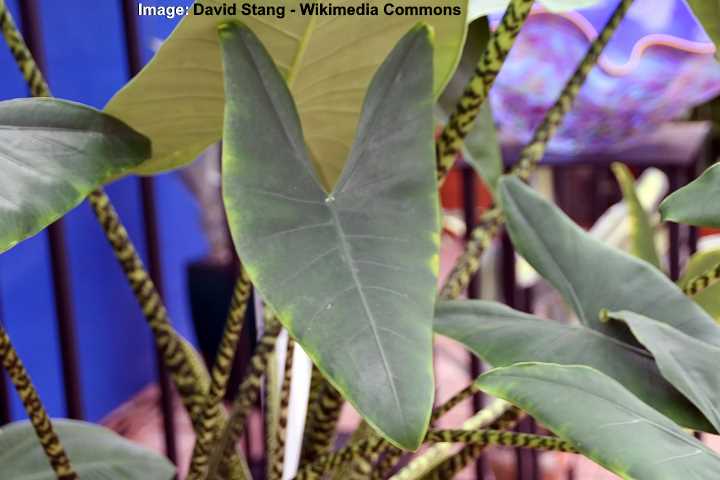
Alocasia zebrina is famous for its unusual patterned stalks which have a ‘zebra’ or ‘leopard’ look
The Alocasia zebrina is a compact elephant ear houseplant with unusual patterns on thick leaf stems. Like all elephant ear plants, the Alocasia zebrina species has arrowhead leaves. The thick, waxy green leaves have light, faint vein markings. The attractive feature of the Alocasia zebrina is its spotted stems that look like leopard skin.
This unusual houseplant is also called the Alocasia Leopard or Alocasia zebrina Tiger. The fast-growing elephant ear plant thrives in warm, humid conditions, and grows in moist potting soil.
Alocasia Frydek (Alocasia micholitziana ‘Frydek’)
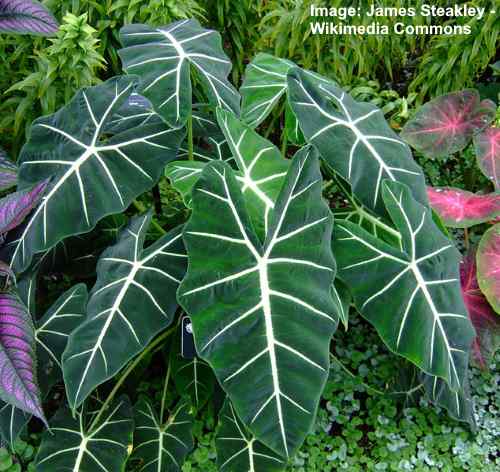
To care properly for Alocasia Frydek plant, make sure it gets enough indirect sunlight
The Alocasia Frydek is an elephant ear plant which is also known as the Green Velvet plant due to its soft, green smooth velvety leaves. Like the Amazonian Alocasia, the Frydek variety has dark green leaves contrasting with the protruding white veins that form spiked patterns, but the leaves are velvety and not glossy. As a houseplant, the Green Velvet Alocasia grows between 2 and 3 ft. (0.6 – 1 m).
Taro (Colocasia esculenta)
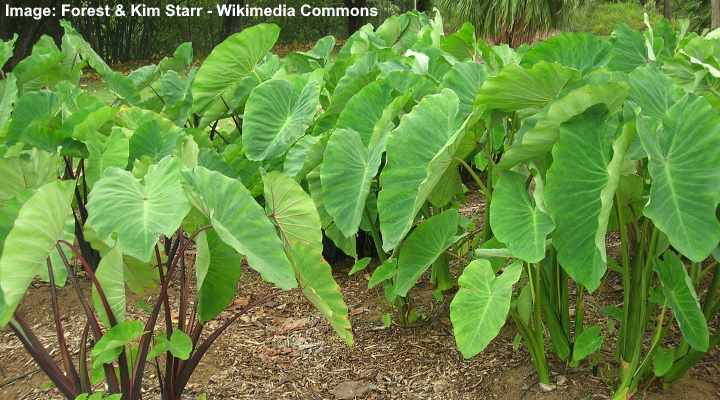
Colocasia esculenta (taro plant) has large green leaves that give exotic look to the garden
The Taro plant (Colocasia esculenta) has huge green arrowhead leaves growing at the end of long arching stalks. Taro plant’s leaves droop down and give sunny gardens a tropical look. Colocasia esculenta is an easy-to-grow tropical plant to add spectacular exotic foliage to gardens. Taro plants grow between 3 and 6 ft. (1 – 1.8 m) tall.
Taro plants thrive in USDA zones 8 through 12. Plant the elephant ear bulbs in the ground in partial sun and water frequently during the summer.
Giant Elephant Ear (Colocasia gigantea ‘Thailand Giant’)
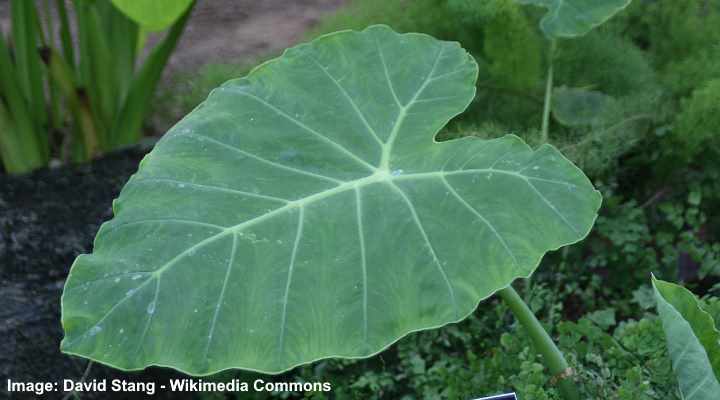
Giant elephant ear is a very large plant that needs a lot of space in the garden
As its name suggests, the giant elephant ear Colocasia gigantea has enormous, rounded heart-shaped leaves. The bluish-green leaves grow between 4 and 6 ft. (1.2 – 1.8 m) long and up to 5 ft. (1.5 m) wide. The impressive ornamental foliage plant creates a tropical focal point in any large garden.
You can grow Giant Elephant Ear plants in large containers or water gardens. The tuberous bulbs grow well in soggy conditions. However, it would be best if you had plenty of space to grow the ‘Thailand Giant’ Colocasia because the plant can grow up to 10 ft. (3 m) tall and wide.
Colocasia Esculenta ‘Black Magic’
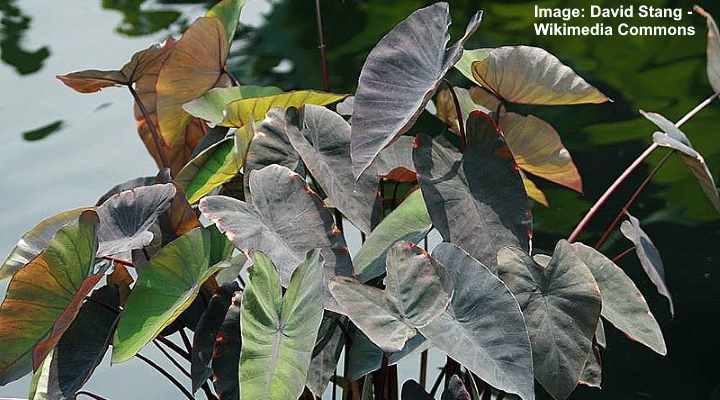
Elephant ear Colocasia Esculenta ‘Black Magic’ has dark purple-black arrowhead shaped leaves
The elephant ear ‘Black Magic’ has drooping purple-black leaves. The stunning dark purple leaves can sometimes look velvety black. The smooth purple elephant ear leaves grow up to 2 ft. (0.6 m) long and have the classic arrowhead shape. The dark purple Taro plant creates a stunning focal point in tropical gardens.
Plant Colocasia esculenta ‘Black Magic’ in partial sun and moist soil. These moisture-loving purple foliage plants can grow in ponds and streams or large containers.
Colocasia Esculenta ‘Illustris’
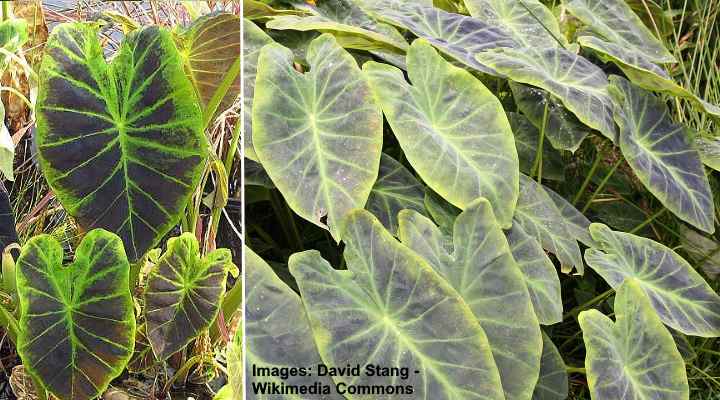
Colocasia esculenta ‘Illustris’ has dark large leaves with green veins
The Colocasia esculenta ‘Illustris’ has blackish-purple elephant ear leaves growing at the end of long arching stalks. The heart-shaped dark elephant ear leaves have contrasting bright green veins. The dramatic mammoth elephant ear leaves grow up to 3 ft. (1 m) long. Like all elephant ear plants, the ‘Illustris’ Colocasia occasionally blooms with spathe flowers outdoors.
Colocasia plants grow in USDA zones 8 through 11. You can also grow the enormous plant in a large container as an exotic houseplant indoors during cold winters.
Xanthosoma Sagittifolium (Elephant Ears)
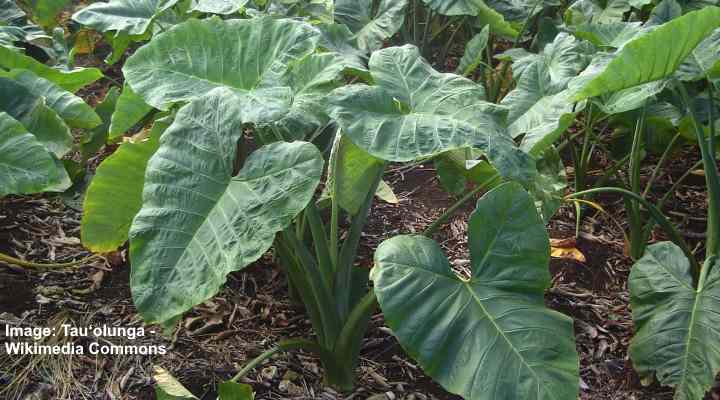
Elephant ear Xanthosoma sagittifolium is a tall plant with large wrinkled leaves
The elephant ear Xanthosoma sagittifolium is a fast-growing elephant ear plant with large leaves that stand up to between 6 and 9 ft. (2 – 2.7 m) tall. The massive broad arrowhead elephant ear leaves have a distinct wrinkled appearance and wavy edges. The elephant ear leaves grow on stiff stalks and are 4 ft. (1.2 m) long and 3 ft. (1 m) wide.
Xanthosoma sagittifolium is generally cultivated for its edible tuberous roots. The tropical herbaceous plant grows along waterways, wetlands, and swamps.
Elephant Ears Xanthosoma ‘Lime Zinger’
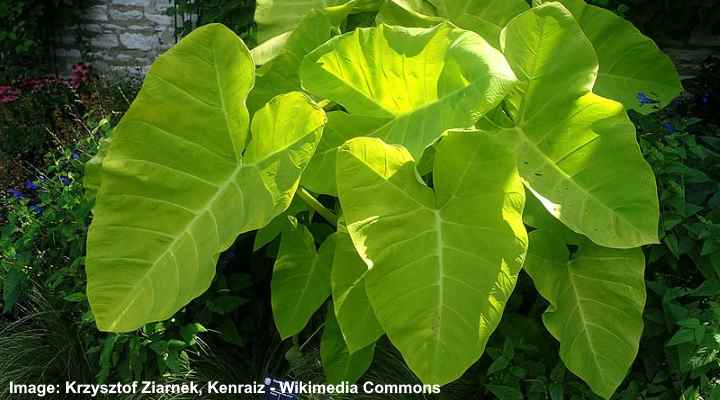
Xanthosoma ‘Lime Zinger’ add bright color to the garden
Xanthosoma ‘Lime Zinger’ has bright green arrowhead elephant ear leaves with yellowish veins. The lime-green elephant ear leaves grow around 1.5 ft. (0.5 m) long, and the clumping foliage doesn’t grow more than 4 ft. (1.2 m) tall. This elephant ear plant grows best in partial sun to keep the color of leaves vibrant.
You can grow Xanthosoma ‘Lime Zinger’ in containers as a patio or deck plant. In temperate climates, you can overwinter the tropical plant indoors.
Angel Wings (Caladium ‘Candidum’)
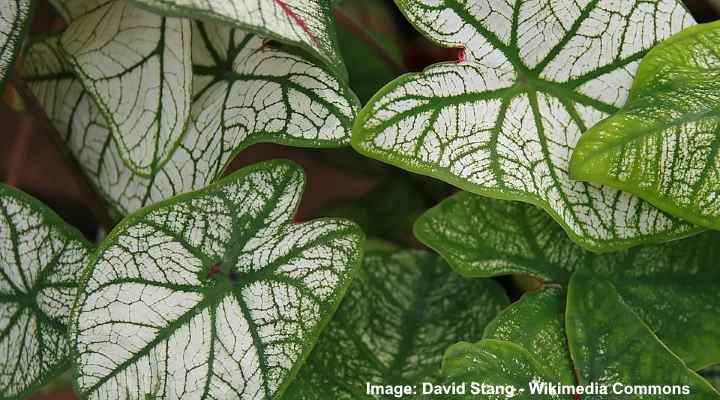
Caladium ‘Candidum’ has decorative and unusual white and green patterned leaves
The elephant ears Angel Wings ‘Candidum’ has spectacular white arrowhead-shaped leaves with a network of dark green patterns. The highly ornamental elephant ear leaves contrast nicely with the green foliage of other garden plants. This tropical jungle Caladium plant grows well in full shade and will help lighten up dark spaces.
Caladium elephant ears are not tolerant of frost. You can grow them in the ground in USDA zones 9 through 12. In colder climates, grow the white leafy plants in containers. Alternatively, you can dig up the bulbs in the fall after the plant dies back.
Caladium ‘Candidum Junior’
Also called the Fancy-Leafed Caladium, this compact cultivar is a smaller version of the Angel Wings plant. This tropical species with lightly-colored foliage has heart-shaped white and green leaves. The Caladium ‘Candidum Junior’ is a shade-loving elephant ear plant cultivar. The elephant ears plant grows 1 ft. (0.3 m) tall and wide.
Due to its low-growing nature and drooping leaves, Caladium ‘Candidum Junior’ is an ideal ground cover plant for shade in frost-free gardens.
Caladium Bicolor (Caladium x hortulanum)
Caladium bicolor elephant ear plants have some of the most stunning foliage on any plant. The multi-colored leaves on Caladium bicolor varieties can have rainbow colors of pink, red, green, and white. Some bicolor elephant ear leaves have vein patterns in striking contrast to the leaf colors.
Variegated Caladium bicolor leaves grow between 7” and 17” (17 – 43 cm) long and up to 10” (25 cm) wide. Grow these thirsty plants along shaded borders, as a specimen plant, or as ground cover.
There are many beautiful Caladium bicolor cultivars, each with fascinating colorful foliage. Here are a few examples of bicolor elephant ear varieties that grow in tropical gardens or beautiful houseplants:
Caladium ‘White Queen’

Caladium ‘White Queen’ has stunning red, cream and green leaves
The Caladium ‘White Queen’ cultivar has silvery-green arrowhead elephant ear leaves with scarlet-red veins that seem to bleed into the leaves. New leaf growth on this elephant ear variety is a dusty pink color before maturing into contrasting white and red colors. Caladium ‘White Queen’ grows up to 2 ft. (0.6 m) high and wide.
Grow the ‘White Queen’ Caladium as a houseplant in shaded areas if you live in growing zones lower than 9.
Caladium ‘Red Flash’
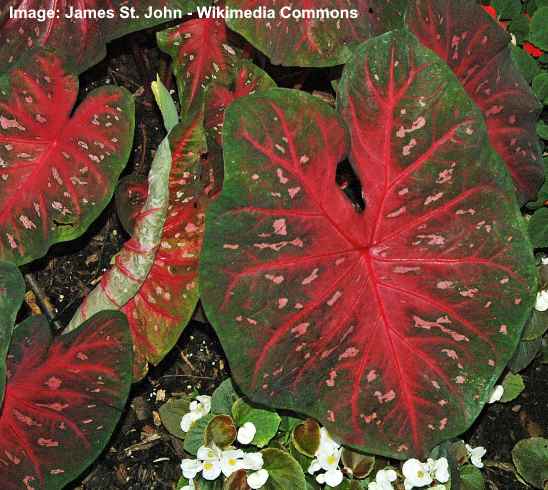
Caladium ‘Red Flash’ has ornamental green leaves with red veins and pink spots
The fancy-leafed Caladium ‘Red Flash’ has dark green elephant ear leaves with bright red veins and pink spots. The leaves on this elephant ear plant look like red paint has been splashed on lush green leaves. From all the Caladium varieties, this plant is relatively tolerant of the sun and grows well in partial shade.
Caladium ‘Carolyn Whorton’

Caladium ‘Carolyn Whorton’ has beautiful green and pink leaves with red veins
The Angel Wings Caladium ‘Carolyn Whorton’ has striking heart-shaped pink leaves, green edges, and conspicuous red veins. The vivid colors on this elephant ears cultivar make for a colorful focal point in any room. The shade-loving Caladium grows in the ground in warm climates to brighten up borders and flower beds.
Related articles:
